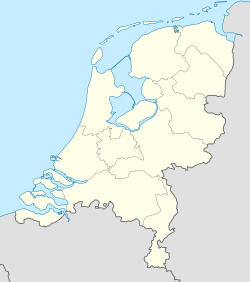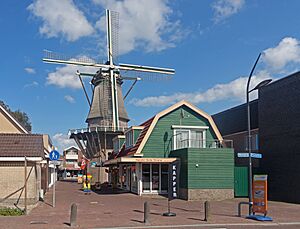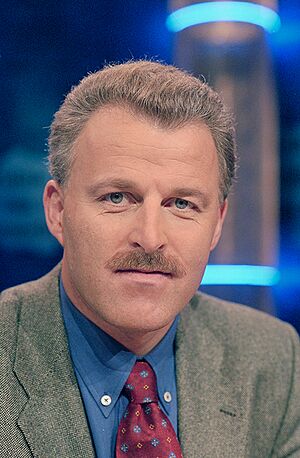Aalsmeer facts for kids
Quick facts for kids
Aalsmeer
|
|||
|---|---|---|---|
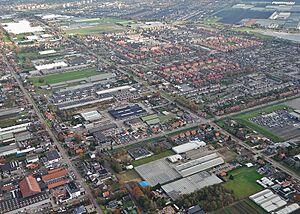
Aerial photo of Aalsmeer, 2014
|
|||
|
|||
| Nickname(s):
Flower capital of the world
|
|||

Location in North Holland
|
|||
| Country | Netherlands | ||
| Province | North Holland | ||
| Region | Amsterdam metropolitan area | ||
| Government | |||
| • Body | Municipal council | ||
| Area | |||
| • Total | 32.29 km2 (12.47 sq mi) | ||
| • Land | 20.44 km2 (7.89 sq mi) | ||
| • Water | 11.85 km2 (4.58 sq mi) | ||
| Elevation | -0.1 m (0 ft) | ||
| Population
(May 2014)
|
|||
| • Total | 30,878 | ||
| • Density | 1,511/km2 (3,910/sq mi) | ||
| Demonym(s) | Aalsmeerder | ||
| Time zone | UTC+1 (CET) | ||
| • Summer (DST) | UTC+2 (CEST) | ||
| Postcode |
1430–1433
|
||
| Area code | 0297 | ||
| Website | Aalsmeer.nl | ||
Aalsmeer is a town and a municipality in the Netherlands. It is located in the province of North Holland. The name Aalsmeer comes from the Dutch words for "eel" (aal) and "lake" (meer).
The town sits next to the Westeinderplassen lake, which is a large open water area in the Randstad region. It is also bordered by the Ringvaart Canal. Aalsmeer is about 13 kilometers (8 miles) southwest of Amsterdam.
Aalsmeer is often called the "flower capital of the world." This is because it is home to the Aalsmeer Flower Auction, which is the largest flower auction globally. Many plant nurseries and a special research center for floriculture (flower growing) are also found here.
Contents
Towns and Villages in Aalsmeer
The municipality of Aalsmeer includes several smaller places. These are the main town of Aalsmeer itself, and the villages of Kudelstaart, Oosteinde. There is also a small hamlet called Calslagen.
Aalsmeer's Unique Landscape
Aalsmeer is located near where the Haarlem Lake used to be. The older parts of the town are built on peat, which is a type of soil made from decayed plants. The areas around the town are polders. Polders are pieces of land that were once underwater but have been reclaimed. These polders are made of loamy soil and are about 9 to 15 feet (3 to 4.5 meters) below sea level.
Aalsmeer's Past: From Wilderness to Flowers
Aalsmeer was first mentioned in a document from 1133. Back then, it was called "Alsmar." It was a wild area with many alder and willow forests.
Early Development and Land Reclamation
Over time, people dug up large amounts of peat from the land. This created big lakes and ponds, like the Oosteinderpoel and Westeinderplassen. Because there was little dry land left, the people of Aalsmeer started to focus on fishing. They also grew many trees in nurseries.
To get more dry land, people began to reclaim the lakes. The Stom Lake was reclaimed in 1650, and the Horn Lake in 1674. In 1852, the huge Haarlem Lake, which was next to Aalsmeer, was also turned into a polder. After that, other ponds like Schinkelpoel and Legmeer were reclaimed.
The Rise of Horticulture
As peat digging stopped and fishing became less important, growing plants became more popular. Strawberry farming grew a lot between 1850 and 1885. The strawberry even became a symbol on the flag of Aalsmeer. The flag's colors – red, green, and black – represent the fruit, leaf, and soil.
Around 1880, people started growing flowers, especially roses, in greenhouses. Farmers used to sell their strawberries and flowers to traders. These traders would take the goods by boat to the market in Amsterdam. However, the trade soon moved to Aalsmeer itself. Auctions started happening in local cafes. By 1912, two main flower auction companies were set up: Centrale Aalsmeerse Veiling and Bloemenlust.
Aalsmeer During World War II
During World War II, Aalsmeer faced challenges due to its local leadership. The town's mayor at the time had strong beliefs that caused problems. The German commander in the Netherlands, Friedrich Christiansen, visited Aalsmeer often. After the war, many legal cases were held against people from Aalsmeer who had supported the wartime regime.
Growth After the War
By 1950, Aalsmeer had 12,500 people living there. In 1968, the two main flower auction companies joined together. A large new auction building was finished in 1972 and made even bigger in 1999.
Aalsmeer's Economy: Flowers and More
The flower auction building of FloraHolland is one of the largest commercial buildings in the world. It has a floor space of about 999,000 square meters (10.7 million square feet). Its location close to Amsterdam Schiphol Airport helps growers send flowers all over the world.
On January 1, 2008, the Aalsmeer flower auction merged with other auctions. It became part of FloraHolland, which is now the biggest auction market for flowers in the world. Many types of flowers are grown and sold here, including carnations, roses, lilacs, freesias, and chrysanthemums.
Besides flowers, other industries are important to Aalsmeer's economy. These include dairy farming, beef production, and growing potatoes, vegetables, and fruit. The town also produces farm products, sporting goods, boats, and packaging materials. The Endemol television studios are located in the old Central Auction building. The Bloemenlust building is now a place for sports, events, and meetings.
Culture and Events in Aalsmeer
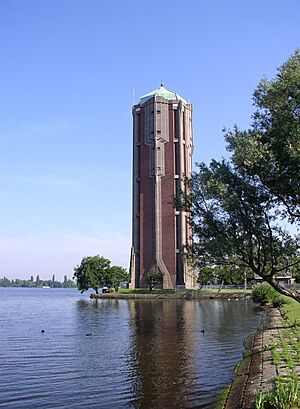
Aalsmeer hosts several fun events and festivals each year. One well-known event was the Flower Parade (Bloemencorso). This parade happened every first Saturday in September for 60 years. However, it stopped in 2007 when the flower auction no longer sponsored it.
Other yearly events include the "Pramenrace," which takes place every second Saturday in September. There is also the Bands Night (Bandjesavond) in June, where local music groups perform.
Music Scene in Aalsmeer
Aalsmeer has a lively music scene. Many bands and artists from Aalsmeer and Kudelstaart have become known since the 1970s. Some of these groups include Eton Crop, Hobo String band, The Whatts, Livin' at A, and Café Blue.
Famous People from Aalsmeer
Many notable people have come from Aalsmeer. These include politicians, writers, and athletes.
- Jan de Pous (1920–1996) was a Dutch politician and economist.
- Ada van Keulen (1920–2010) was a Dutch woman who helped in the resistance during World War II.
- Joost Hoffscholte (born 1942) was the Mayor of Aalsmeer from 1985 to 2007.
- Fred Borgman (1946–1996) was a Dutch politician and alderman of Aalsmeer.
- Theodore van Houten (1952–2016) was a Dutch-British writer and journalist.
- Peter R. de Vries (1956–2021) was a famous Dutch investigative journalist.
- Pieter Litjens (born 1968) was the Mayor of Aalsmeer from 2007 to 2012.
Sports Figures
Aalsmeer has also produced several athletes who competed in the Olympic Games.
- IJke Buisma (1907–1994) was a Dutch high jumper who competed in the 1928 Summer Olympics.
- Jan Bol (1924–2010) was a Dutch sailor who competed in the 1968 Summer Olympics.
- Jan Jongkind (born 1932) was a sailor who competed in the 1964 Summer Olympics.
- Piet Bon (1946–2010) was a Dutch rower who competed in the 1968 Summer Olympics.
- Michael Buskermolen (born 1972) is a retired Dutch footballer who played for AZ Alkmaar.
- David Pel (born 1991) is a Dutch tennis player.
See also
 In Spanish: Aalsmeer para niños
In Spanish: Aalsmeer para niños




